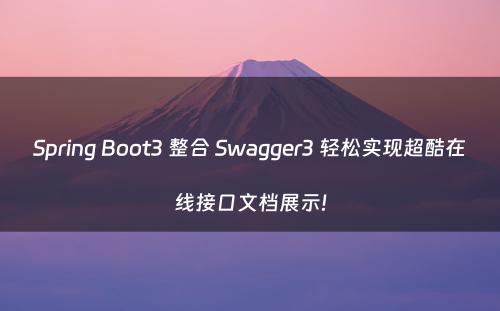网站首页 > java教程 正文
在当今互联网大厂开发的快节奏环境中,高效且清晰的接口文档对于项目的顺利推进至关重要。对于使用 Spring Boot3 进行开发的你来说,是否渴望找到一种便捷的方式来整合 Swagger3,从而轻松实现超酷的在线接口文档展示呢?别着急,本文将为你一一揭晓。
Spring Boot3 与 Swagger3 简介
Spring Boot3

Spring Boot3 于 2022 年 11 月 24 日发布,它极大地简化了独立的、生产级别的基于 Spring 应用的创建,你几乎可以做到 “拿来就运行” 。它对 Spring 平台和第三方库持有特定的观点,使得开发者能够以最小的麻烦启动项目,大多数 Spring Boot 应用只需要极少的 Spring 配置。并且,Spring Boot3 支持 Java 17,还引入了 Spring Native 等重要特性,能够将 Spring 程序编译成本地可执行的镜像文件,显著提升启动时间、峰值性能和内存利用率。
Swagger3
Swagger3 是基于 OpenAPI 3 规范的实现。OpenAPI 规范定义了一个标准的、与语言无关的 RESTful API 接口,使得人们和计算机无需访问源代码、文档或通过网络流量检查,就能发现和理解服务的功能。Swagger 提供了一系列工具,如 Swagger Editor(基于浏览器的编辑器,可编写 OpenAPI 规范)、Swagger UI(将 OpenAPI 规范呈现为交互式 API 文档)以及 Swagger Codegen(通过为 OpenAPI 规范定义的任何 API 生成服务器存根和客户端 SDK 来简化构建过程)。目前,Swagger3 是 Swagger 的最新版本,相较于 Swagger2,它配置更少,使用更加方便。
Spring Boot3 整合 Swagger3 的具体步骤
添加 Swagger3 依赖
在 Spring Boot3 项目的 pom.xml 文件中,你需要添加
springdoc-openapi-starter-webmvc-ui 依赖。具体配置如下:
<dependency>
<groupId>org.springdoc</groupId>
<artifactId>springdoc-openapi-starter-webmvc-ui</artifactId>
<version>2.0.3</version>
</dependency>配置 Swagger3
在 Spring Boot 应用中,创建一个配置类,例如 OpenApiConfig.java 。在该类中,你可以定义 OpenAPI 相关的配置信息,包括基础 URL、标题、版本、作者联系信息、描述、许可证等。示例代码如下:
package com.example.config;
import java.util.List;
import org.springframework.beans.factory.annotation.Value;
import org.springframework.context.annotation.Bean;
import org.springframework.context.annotation.Configuration;
import io.swagger.v3.oas.models.OpenAPI;
import io.swagger.v3.oas.models.info.Contact;
import io.swagger.v3.oas.models.info.Info;
import io.swagger.v3.oas.models.info.License;
@Configuration
public class OpenApiConfig {
@Value("${springdoc.version}")
private String apiVersion;
@Value("${springdoc.title}")
private String apiTitle;
@Value("${springdoc.description}")
private String apiDescription;
@Value("${springdoc.termsOfServiceUrl}")
private String termsOfServiceUrl;
@Value("${springdoc.contact.name}")
private String contactName;
@Value("${springdoc.contact.url}")
private String contactUrl;
@Value("${springdoc.contact.email}")
private String contactEmail;
@Value("${springdoc.license.name}")
private String licenseName;
@Value("${springdoc.license.url}")
private String licenseUrl;
@Bean
public OpenAPI customOpenAPI() {
return new OpenAPI()
.info(new Info()
.title(apiTitle)
.version(apiVersion)
.description(apiDescription)
.termsOfService(termsOfServiceUrl)
.contact(new Contact()
.name(contactName)
.url(contactUrl)
.email(contactEmail))
.license(new License()
.name(licenseName)
.url(licenseUrl)));
}
}这里的配置信息可以通过在 application.properties 或 application.yml 文件中进行配置,例如
springdoc.version=1.0
springdoc.title=My API
springdoc.description=This is my API description
springdoc.termsOfServiceUrl=https://example.com/terms
springdoc.contact.name=John Doe
springdoc.contact.url=https://example.com/contact
springdoc.contact.email=john@example.com
springdoc.license.name=MIT License
springdoc.license.url=https://opensource.org/licenses/MIT如果你使用的是 Spring Webflux,还需要添加相应的依赖和配置。对于 Spring Webflux 项目,添加
springdoc-openapi-starter-webflux-ui依赖:
<dependency>
<groupId>org.springdoc</groupId>
<artifactId>springdoc-openapi-starter-webflux-ui</artifactId>
<version>2.0.3</version>
</dependency>然后配置 Swagger3,示例配置类如下:
package com.example.config;
import org.springframework.context.annotation.Bean;
import org.springframework.context.annotation.Configuration;
import org.springframework.web.reactive.config.EnableWebFlux;
import io.swagger.v3.oas.models.OpenAPI;
import io.swagger.v3.oas.models.info.Info;
@Configuration
@EnableWebFlux
public class OpenApiWebFluxConfig {
@Bean
public OpenAPI customOpenAPI() {
return new OpenAPI()
.info(new Info()
.title("WebFlux API")
.version("1.0")
.description("This is a WebFlux API with Swagger3"));
}
}使用 Swagger 注解
在你的控制器类和方法上,可以使用 Swagger 的注解来提供更多的接口信息和自定义。例如:
package com.example.controller;
import org.springframework.web.bind.annotation.GetMapping;
import org.springframework.web.bind.annotation.RequestMapping;
import org.springframework.web.bind.annotation.RestController;
import io.swagger.v3.oas.annotations.Operation;
import io.swagger.v3.oas.annotations.media.Content;
import io.swagger.v3.oas.annotations.media.Schema;
import io.swagger.v3.oas.annotations.responses.ApiResponse;
import io.swagger.v3.oas.annotations.responses.ApiResponses;
@RestController
@RequestMapping("/api")
public class ExampleController {
@GetMapping("/example")
@Operation(summary = "Get example data", description = "Returns example data from the server")
@ApiResponses(value = {
@ApiResponse(responseCode = "200", description = "Successfully retrieved data",
content = @Content(schema = @Schema(implementation = String.class))),
@ApiResponse(responseCode = "404", description = "Data not found",
content = @Content)})
public String getExampleData() {
return "This is example data";
}
}访问 Swagger UI
当你完成上述配置并启动 Spring Boot 应用后,就可以通过浏览器访问 Swagger UI 来查看和测试你的 API 接口文档了。默认情况下,访问路径为
http://localhost:8080/swagger - ui/ 或
http://localhost:8080/swagger - ui/index.html (请根据你的实际端口号进行替换)。在 Swagger UI 界面中,你可以清晰地看到各个接口的信息,包括接口路径、请求方法、参数、响应等,并且还可以直接在界面上进行接口测试。
总结
通过以上步骤,你已经成功地在 Spring Boot3 项目中整合了 Swagger3,实现了在线接口文档展示。这不仅提高了开发效率,使得前后端开发人员能够更清晰地理解接口,还方便了项目的维护和管理。在实际项目中,你可以根据具体需求进一步优化 Swagger 的配置,例如添加安全认证、自定义文档样式等。现在,赶紧行动起来,让你的项目拥有超酷的在线接口文档展示吧!
- 上一篇: 分享 - 短网址生成接口(最新官方api)
- 下一篇: 零侵入!试试这款Api接口文档生成器!
猜你喜欢
- 2025-05-02 dify案例分享-API文档生成接口代码
- 2025-05-02 从 0 到 1 实战 Spring Boot 3:手把手教你构建高效 RESTful 接口
- 2025-05-02 原来大牛们口中的接口Mock测试是长这样的,今天我终于搞懂了
- 2025-05-02 什么是函数式接口?(函数式接口使用场景)
- 2025-05-02 请求合并的三种方式,大大提高接口性能
- 2025-05-02 dify案例:dify导入本地Java接口作为function call工具
- 2025-05-02 【开源推荐】PhalApi2.13(致敬版) 发布,PHP 轻量级开源接口框架
- 2025-05-02 Java:在Java中使用私有接口方法(java中如何调用私有成员变量)
- 2025-05-02 Java接口与抽象类:核心区别、使用场景与最佳实践
- 2025-05-02 实现AI API Tokens计费产品方案和Java技术实现设计(含源码分享)
欢迎 你 发表评论:
- 最近发表
- 标签列表
-
- java反编译工具 (77)
- java反射 (57)
- java接口 (61)
- java随机数 (63)
- java7下载 (59)
- java数据结构 (61)
- java 三目运算符 (65)
- java对象转map (63)
- Java继承 (69)
- java字符串替换 (60)
- 快速排序java (59)
- java并发编程 (58)
- java api文档 (60)
- centos安装java (57)
- java调用webservice接口 (61)
- java深拷贝 (61)
- 工厂模式java (59)
- java代理模式 (59)
- java.lang (57)
- java连接mysql数据库 (67)
- java重载 (68)
- java 循环语句 (66)
- java反序列化 (58)
- java时间函数 (60)
- java是值传递还是引用传递 (62)

本文暂时没有评论,来添加一个吧(●'◡'●)